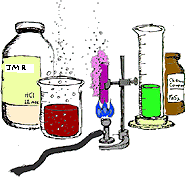


Starting with a home lab
For the home chemist, there are two classes of chemistry, which can be explored best:
- Aqueous inorganic chemistry
- Pyrotechnics, dry high temperature chemistry
This site emphasizes on aqueous inorganic chemistry, although some dry chemical experiments and high temperature experiments are described as well.
Aqueous chemistry is one of the safest parts of chemistry, both from the point of view of risk of fire and explosions and from the point of view of health. This makes aqueous chemistry really suitable for the home. This all said, aqueous chemistry certainly needs not be dull and uninteresting. Also without fire, boom's and flashes, chemistry can be really interesting.
Pyrotechnics can be very beautiful and rewarding, but there also is a higher inherent risk. The experiments on this site have a considerably lower risk profile.
Other fields of chemistry, such as organic chemistry and chemistry in non-aqueous solvents, is covered a little here as well, but coverage on these subjects is limited. Interesting organic chemistry frequently requires specialist glassware and non-aqueous solvents. Reactions in organic chemistry frequently are slow and incomplete. Another problem with organic chemistry is the frequent use of highly volatile and toxic solvents and reagents. This makes organic chemistry less suitable for the home.
![]()
When you want to start with a home lab, then you need some equipment and you need a set of chemicals. This page covers the chemicals, which are most suitable to start with. When you have the chemicals, mentioned on this page, then there is a lot to explore already. In the elements section of this site, compounds, suitable for the home lab are covered in a more systematic way.
If you really are in for pyrotechnics, then consult some of these links. On this website, pyrotechnics is not covered in great detail.
back to miscellaneous main page